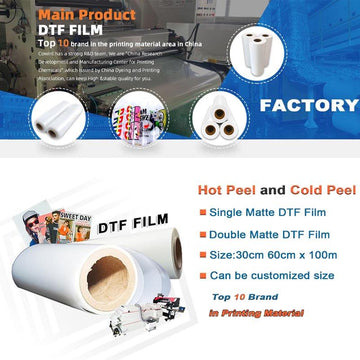🎯 Why Heat-Press Settings Matter
Even perfect printing and curing can be ruined by the wrong press profile. Temperature, time, and pressure control bond strength, edge cleanliness, color, and hand feel. Nail these, and your returns drop.
🧵 Fabric-by-Fabric Settings (Copy → Test → Scale)
Press with a smooth Teflon or parchment sheet. Follow your film’s hot / warm / cold peel guidance.
| Fabric | Temp | Time | Pressure | Peel | Post-Press | Notes |
|---|---|---|---|---|---|---|
| Cotton (jersey/tee) | 160 °C | 12–15 s | Med-firm | per film | 6–8 s | Most forgiving; aim for soft hand |
| Cotton Fleece / Hoodies | 165 °C | 15–18 s | Firm | per film | 8–10 s | Use coarser powder if heavy loopback |
| Polyester (light) | 150–155 °C | 15–20 s | Medium | per film | 6–8 s | Lower temp to reduce dye migration |
| Poly/Spandex (stretch) | 150–155 °C | 15–20 s | Medium | per film | 8–10 s | Elastic-friendly powder, avoid overheat |
| Nylon | 150 °C | 18–22 s | Medium | per film | 8–10 s | Test adhesion; some nylons need primer |
| Canvas / Tote | 165 °C | 15–18 s | Firm | per film | 8–10 s | Pre-press 3–5 s to flatten seams |
| Denim | 160–165 °C | 15–18 s | Firm | per film | 8–10 s | Watch thickness; steady, even pressure |
| Leather / PU | 150 °C | 12–15 s | Light-med | warm/cold | 6–8 s | Protect surface; avoid glossing |
| Pique / Textured | 160 °C | 15–18 s | Firm | per film | 8–10 s | Use fine powder for clean edges |
Pro Tip: If edges lift after peel, increase pressure or add 2–3 s; if whites yellow, drop 3–5 °C or shorten by 2–3 s.
🧪 Your 6-Step Press Routine (No Guesswork)
-
Pre-press garment 3–5 s (remove moisture/wrinkles).
-
Align transfer; cover with protective sheet.
-
Press using table settings above (temp/time/pressure).
-
Peel per film type (hot/warm/cold).
-
Post-press 5–10 s to lock the bond & smooth the surface.
-
Cool flat for 30–60 s before folding or bagging.
🧊 Hot vs. Warm vs. Cold Peel—Which & Why?
-
Hot peel: Speed; good for throughput. Requires clean, confident pull.
-
Warm peel: Safer edges; a nice middle ground.
-
Cold peel: Maximum edge integrity and detail—ideal for micro text/linework.
🧯 Quick Fix Matrix (Press-Side Issues Only)
| Symptom | Likely Cause | Fix Now |
|---|---|---|
| Corner lifting | Pressure too low / time too short | Add pressure or +2–3 s; post-press |
| Grainy/sandy surface | Under-cured powder or temp low | Verify curing; +5 °C or +30–45 s cure |
| White looks creamy/yellow | Overheat during press | Drop 3–5 °C or reduce time |
| Edge halo/bleed | No choke; powder too coarse | Add 0.1–0.2 mm choke; switch to finer powder |
| Cracking after wash | No post-press or brittle bond | Post-press 8–10 s; use elastic-friendly powder |
| Ghosting on poly | Dye migration at high temp | Lower temp/longer press; barrier sheet |
🧰 Press Calibration Checklist
-
Surface level: Use a pressure strip test; corners must match center.
-
True temperature: Cross-check with a surface IR thermometer.
-
Even pressure: Adjust platens; replace worn pads.
-
Environment: 45–55% RH keeps powder and fabric behavior stable.
🧼 Care Card (Copy to Your Packing Slip)
-
Wash inside-out, cold water
-
No bleach; mild detergent
-
Tumble dry low or hang dry
-
Do not iron directly on print (use cloth)
Educating customers cuts warranty claims by 30–50% in many shops.
✅ Takeaway
Consistent, durable DTF results come from correct heat-press profiles tailored to each fabric, a short post-press, and a calibrated press. Lock these in, and your prints will look better, feel softer, and survive more washes.
Why KungFuDTF?
We supply calibrated films, inks, and TPU powders that press cleanly across cotton, poly, canvas, nylon, and stretchwear—plus recipes you can use on day one.







